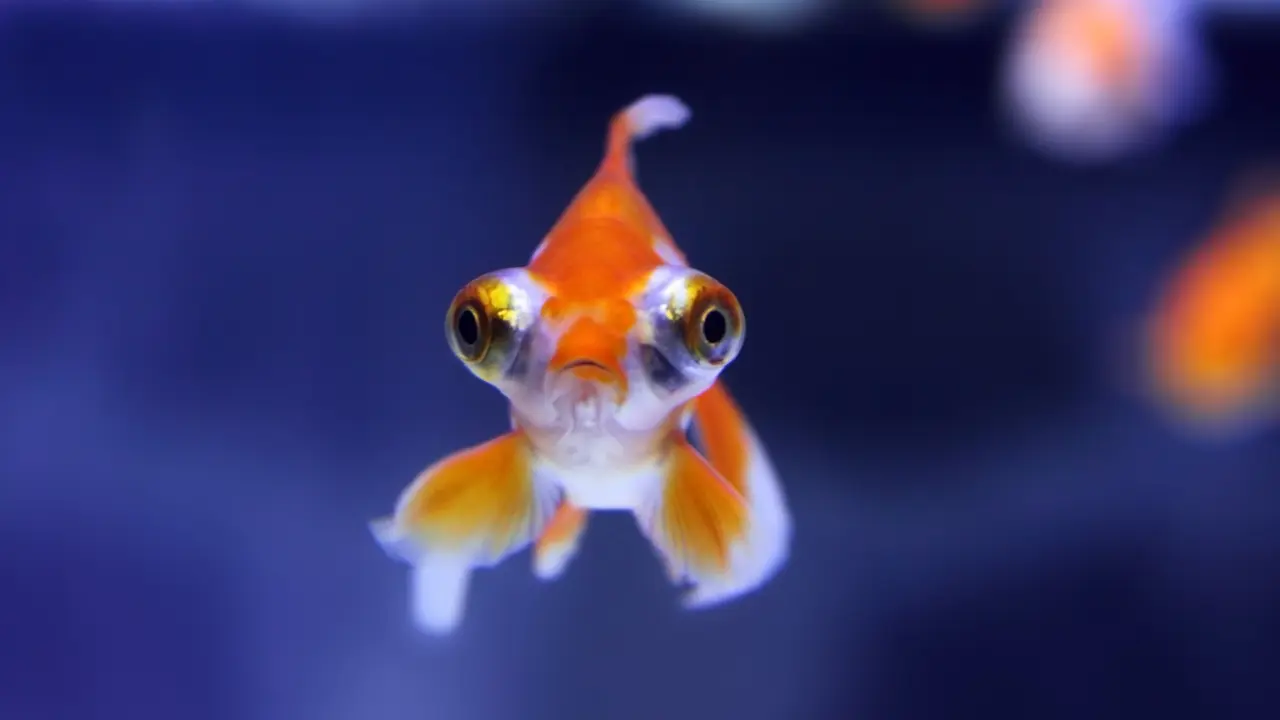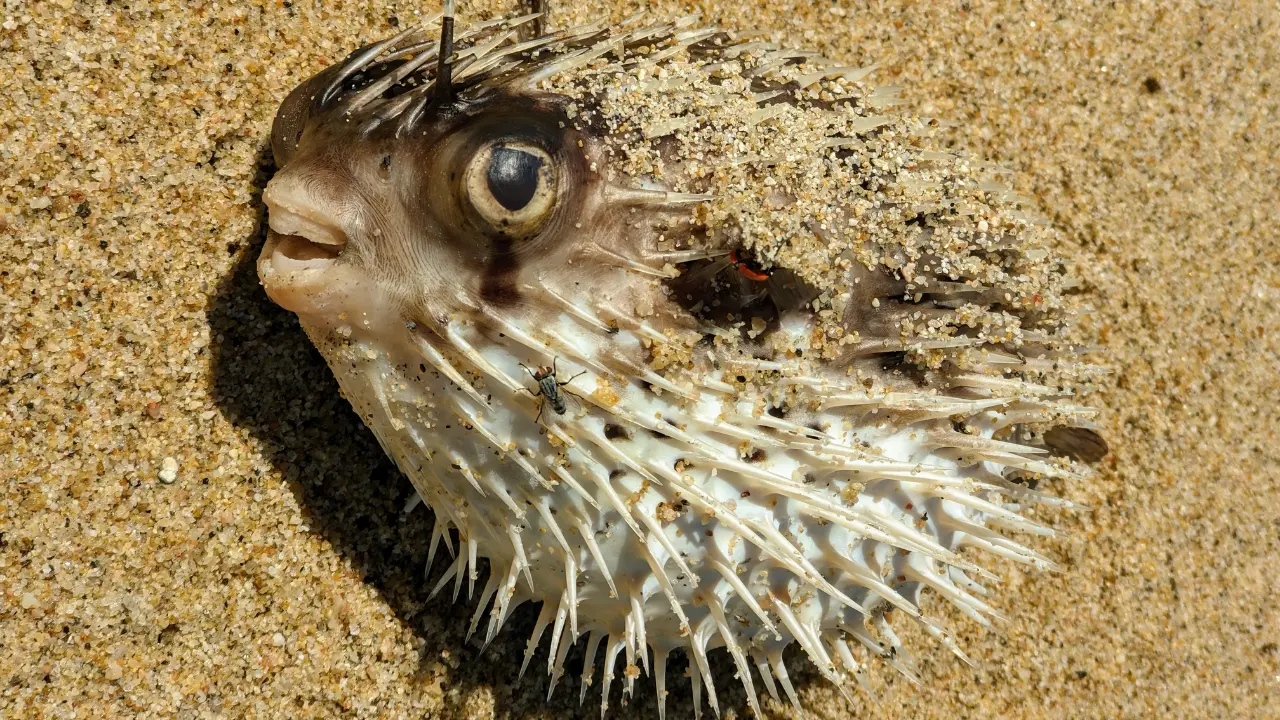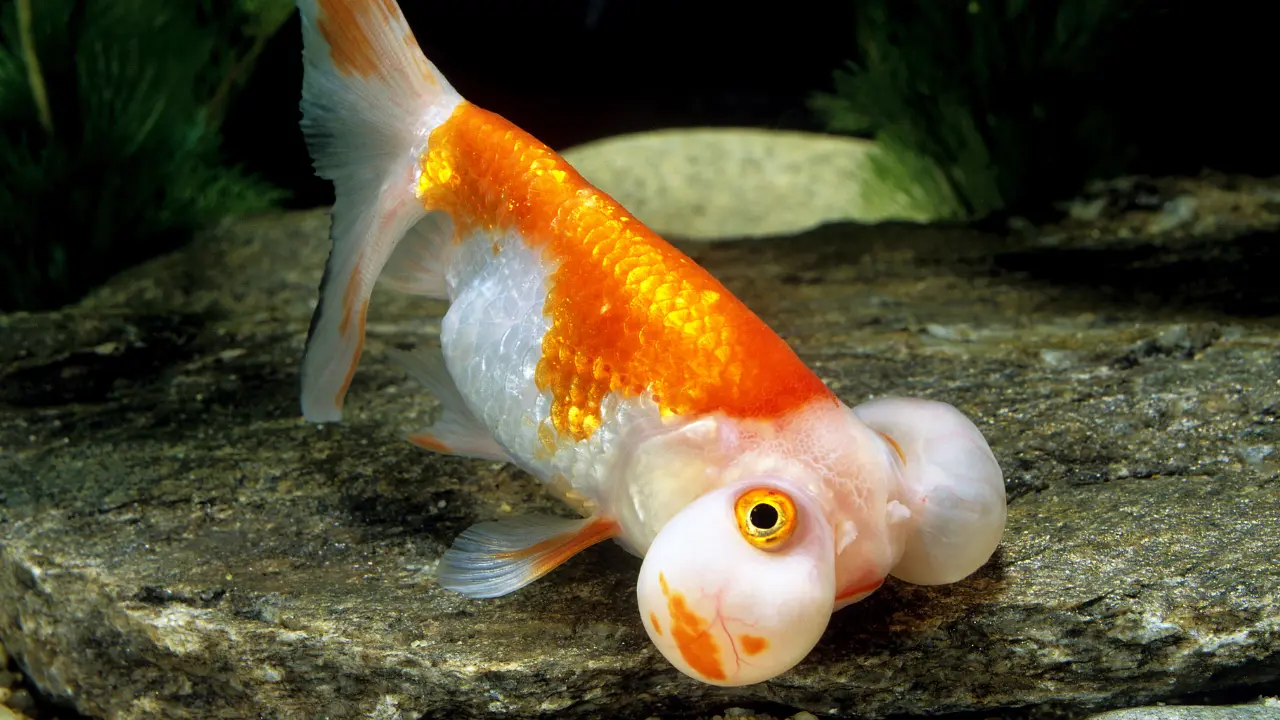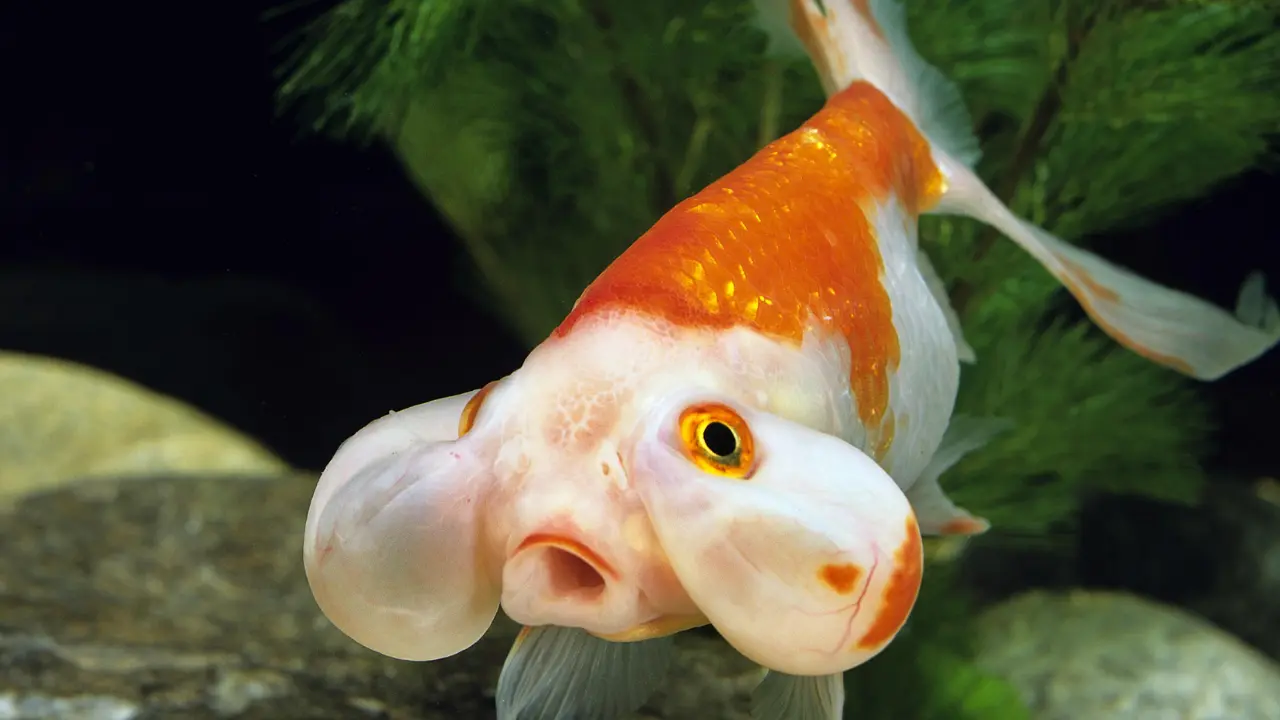The ocean is just full of mysteries and mysterious creatures. Getting to know them all can be a little puzzling. So, let’s explore them one by one in categories. In today’s article, we will discuss the Top 10+ Fish with Big Eyes.
Have you ever wondered: Why do fish have big eyes? What is the purpose of this adaptive vision?
Imagine diving into deep, pitch-black waters. These waters require special survival skills, otherwise, you’re as good as dead. Over the years these huge eyes have evolved so the fish can navigate and detect threats. However, some fish have big eyes just for their ornamental looks and popularity.
What other incredible adaptations will we discover? Dive in and find out!
Telescope Goldfish
The Telescope Goldfish belongs to China. It has a beautiful body and bulging eyes resulting from selective breeding. This unique dragon-like look is popular in Asia and specifically engineered in Japan.
This fish with big eyes is also known as the Dragon Eye or Demekin. Additionally, it has cultural importance in many Asian countries.

Telescope Goldfish have large, protruding eyes, which resemble a telescope. These eyes start to develop when the fish is six months old. Additionally, this fish has a vibrant body with red, calico, and black colors. Moreover, its body is adorned with exquisite patterns. All in all, this black fish with big eyeballs is one-of-a-kind.
Coming back to the eyes, these are just for show. These giant fish eyes provide a larger field of view, which is advantageous in the fish’s natural habitat. However, these eyes are sensitive so they can get infections and injuries. Moreover, these eyes distort the fish’s vision because of their natural placement. Although they look good in the tank, they aren’t good for the fish.
Pufferfish
Pufferfish are found in both marine and freshwater environments worldwide. These fish with big eyes are unique in every way. It has an intriguing look and a unique defense system. Moreover, this fish is extremely adaptive to different environments. Generally, it belongs to the Congo River Basin in Africa.

Pufferfish have a unique round body that inflates when threatened. Moreover, they have huge eyes with ideal placement to provide a large field of view. This vision is useful for escaping predators and navigating in complex waters. These large fish eyes provide excellent vision in low-light environments
Additionally, these large eyes intimidate predators. This combination of vision and daunting looks allows the pufferfish to thrive in diverse environments.
Squirrelfish
The squirrelfish thrives in coral reefs and rocky habitats. This fish inhabits the marine waters of the Atlantic Ocean. Squirrelfish has a nocturnal nature, meaning it rests during the day and hunts at night. Because of this, its eyes have adapted to provide excellent vision in low light.

Squirrelfish have a striking appearance with bright red or pink bodies. Additionally, these beauties are adorned with prominent black eyes. However, these eyes are large and might look too big for the fish.
Moreover, squirrelfish have a range of body size between 6 to 24 inches. Some of these fish might have a spiny and venomous back for defense.
This saltwater fish with big eyes has a sharp sense of evading predators. Thanks to its eyes, these predators can be detected from afar. This helps the squirrelfish survive in low-light and dangerous waters.
Hawaiian Lionfish
The Hawaiian Lionfish originates from the Hawaiian Islands. It thrives in seaward reefs and lagoons. This fish is unique to Hawaii as it inhabits waters near Johnston Island. Usually, this fish thrives in low-light waters. The lionfish is highly adaptable to many water conditions.

This lionfish has a reddish-brown body with white vertical stripes. It has spiny fins that are used to attack prey and predators alike. Moreover, these spines are full of venom and blow a painful sting when touched. Additionally, this fish has big eyes that are used to see clearly in low-light waters.
These large eyes support the nocturnal nature of Hawaiian lionfish. These adaptations are vital for this fish with big eyes as it likes to rest during the day and hunt at night.
Bubble-Eye Goldfish
The Bubble-Eye Goldfish is a fancy variety of goldfish. It originates from China and the surrounding countries. This fish is a result of the centuries-old fish cultivation in Asia.

The Bubble-Eye Goldfish have fluid-filled sacs under their eyes. Looks like someone hasn’t slept for a while!
These eyebags resemble bubbles, thus the name. This fish has a unique body as it lacks the dorsal fin. Moreover, its body has many colors like orange, red, white, and sometimes a combination.
Like the Telescope fish, this fish with big eyes is an ornamental addition to any aquarium. Its eyes are delicate and require extra care to avoid injuries. Although these eyes look good, they have no special function. Due to these sacs, the fish swims slower, resulting in an elegant swimming pattern.
Bigeye Fish
The Bigeye Fish is native to the Atlantic, Pacific, and Indian Oceans. These fish inhabit deep waters around coral reefs and rocky areas. Interestingly, this fish has a nocturnal nature.

This fish has saucer-shaped eyes that look bigger for its body size. These eyes provide enhanced vision in waters with no light. Typically, this fish has an oval-shaped body with an orange or reddish color. This body allows the fish to blend in the coral reefs to hunt effectively.
Additionally, the large fish eyes help this fish detect predators and prey. This way the fish can hide or hunt as needed. Moreover, these enhanced eyes allow the fish to navigate in dark waters.
Rockfish
The Rockfish belongs to the Pacific and North Atlantic oceans. Typically, this fish inhabits rocky shores but it can also thrive in shallow and deep marine waters. Moreover, this fish has a body built to survive in low-light waters.

This fish has huge eyes that look disproportionate to its head. However, these eyes have a vital purpose. As the rockfish likes to delve into deep dark depths, it requires special vision. The huge eyes are adaptations that provide this exceptional vision for this fish to thrive.
In addition, this fish has a reddish or orange body that blends in with the surroundings. This adaptation provides a subtle camouflage for the fish. Overall, these orange fish with big eyes have all they need to survive. Interestingly, some of these fish are known to live up to a century.
Bigeye Tuna
The Bigeye Tuna can be found in temperate oceans across the globe. However, it does not inhabit the Mediterranean Sea. It is widely spread in warm waters due to its migratory nature.

Bigeye Tuna has a metallic blue and silvery body. Additionally, it has large notable eyes for excellent vision in low light. This fish dwells in deep waters so the eyes a vital for its feeding habits.
The large eyes of Bigeye Tuna serve several crucial purposes. One of these includes assistance in navigation. As this fish is known to hunt in the mesopelagic zone, it requires low-light vision. This is the intermediary depth of the ocean.
Lastly, these big eyes play a vital role in migration. They help the fish detect potential predators so it can avoid them as quickly as possible.
Blue Shark
The blue shark is found in temperate and tropical waters worldwide. It generally inhabits deep waters across the globe except Antarctica. They are spread widely because of their migratory nature. They tend to migrate to warm waters.

Blue sharks have a slender body with striking colors like deep and light blue. Typically, they have a white belly. This fish has large eyes and a long conical snout.
The large eyes allow this fish to navigate and hunt in low-light conditions. They help the fish detect predators in dimly lit areas. These adaptations allow the blue sharks to navigate and hunt in dark waters. It also aligns with their nocturnal nature.
Horse-Eye Jack
Horse-Eye Jack originates from the warm, tropical waters of the Caribbean. It has large eyes and a streamlined body.

Horse-Eye Jacks have a beautiful silver body and a forked tailfin. Along with that, it also has disproportionately large eyes. These eyes are placed high on their head, which elevates their distinct look. These oversized eyes are crucial to detect prey and avoid predators in the open ocean.
The big eyes of Horse-Eye Jacks serve several crucial purposes. These eyes help the fish navigate in dark waters and hunt prey. Additionally, these eyes provide a wide range of view which allows the fish to monitor its surroundings.
More Fish with Big Eyes
If you’d like to find out more about fish with big eyes, keep following our articles. For now, here is a more extended list of fish with big eyes.

- Japanese Dragon Eel
- Dragon Goby
- Green Spotted Puffer
- Longspine Squirrelfish
- Norman’s Lampeye Killifish
- Shell-Dwelling Cichlids
- Dwarf Pufferfish
- Porbeagle Shark
- Genie’s Dogfish
- Tarpon
For a more detailed insight on fish with unique characteristics. Check our articles on fish with Big Forehead and fish with Big Lips.
FAQ’s
What is the name of the fish with big eyes?
There are many fish with Big Eyes. Some fish with Big Eyes include the Pincone fish, Angler fish, and Dragon fish. For more fish with big lips, read our article given above.
What does it mean when fish have big eyes?
If your fish doesn’t normally have huge eyes but now it seems like its eyes are getting bigger, it can be a disease. Such issues might include the Popeye disease in which the fish’s eye might swell, bulge, or appear cloudy. This disease requires treatment otherwise the fish can even lose its eyes.
What do big eye fish eat?
It depends on the fish, not their eyes. Generally, most fish with big eyes eat small fish, crustaceans, plankton, squid, and shrimp. Usually, they are hunters however, this might not be true for all fish with big eyes.
Do big eyes impact the vision of a fish?
Yes! Fish with big eyes typically have better vision and a wider view. However, this is the case for most fish, not all of them. In some cases, big fish eyes are only for an ornamental look.
Conclusion
Today we discovered the Top 10+ Fish with Big Eyes. Along with that, we explained the reasons behind these unique adaptations. We also explored how these huge eyes align with the fish’s nature and habitat.
In essence, these big eyes are either designed to look pretty or made to help them see better in the dark. But this is just a glimpse of the underwater. Join us as we discover the depths and find out more about these exciting fish.
Let us know: what you think about these big eyed fishes. Do you find them funny or strategic? Comment below, we’d love to hear your thoughts on this!

